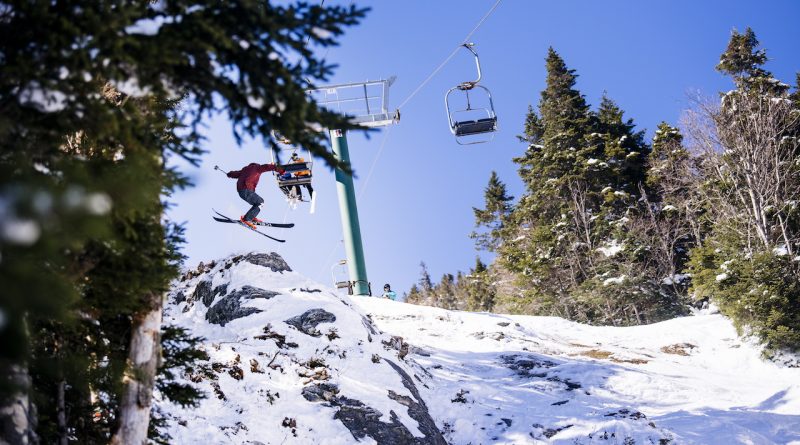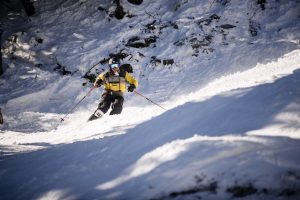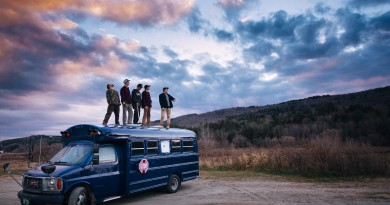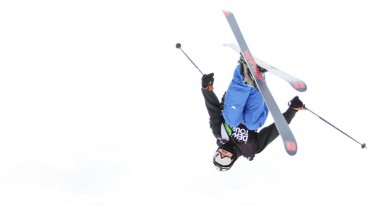Who’s The Best In Vermont?
Spring is a time for unicorn costumes, beer-fueled tailgates and the chance to determine who’s the best on the mountain … at something.
The best skier on the mountain is the one who is having the most fun. Yeah—we’ve all heard that. But that adage doesn’t muffle the chairlift chatter that starts every season. Really, who is the best on the mountain? It doesn’t downshift the party laps or curb the free-form one-upmanship that are regular rites of spring.
Over the years, ski areas have come out with creative ways of corralling the craziness and helping to determine who really is king or queen of the mountain. Whether it’s hucking cliffs, going mach schnell (with a radar gun aimed at your back), bashing bumps, or an all-terrain challenge on skinny skis, these events attempt to determine who the best skiers and riders really are. Or, at least, who’s having the most fun.
20 YEARS OF CASTLEROCK’S EXTREME
“The only thing that might top that 360 is a back flip,” David Babic mused as he looked at his judge’s score card. It was a bluebird day last March and Babic, a former World Cup mogul medalist, squinted into the sun as Noah Ranallo, 24, of Charlotte, Vt. soared off the 20-foot cliff at Sugarbush known as Castlerock.
Ranallo floated against the sky, almost at the level of the double chairs passing by. On the lift heads turned, “YEAH BABY!” a skier screamed as Ranallo began spinning into a heli. The riders twisted in their seats to look back, waiting to see if Ranallo would stomp the landing. He hit hard. You could almost feel each vertebrae compress. He fell back. Then he sprang up, recovered and blazed down through the mogul field.
Castlerock is a hulking, knobby chunk of granite that rears up like a vexed tyrannosaurus rex partway down the trail that runs under Sugarbush’s old double chairlift. It is a classic East Coast run— all-natural terrain, no bulldozed flats, no snowmaking, full of moguls. It flows for nearly a mile as it drops more than 1,600 vertical feet. “There’s nothing artificial or man-made about this,” says John Egan, who has been skiing the terrain here since 1976. “Unlike so many other ski trails, no one blasted out the rock or removed the stumps. What you’re skiing is the real mountain.”
For more than four decades, Egan and his posse have ripped the trail. “I realized I could ski it, top to bottom, in 90 seconds, so we decided to double that and set up a challenge to see who could ski the trail well in under 3 minutes.” That was in 1997.
Babic, 38, who’s been skiing Sugarbush since he was seven, has been part of that group. His father was a liftie here and his brother is currently CFO. At 16, Babic began competing in moguls, making it to the National Team by age 22 and going on to medal in the World Cup finals in 2008. “When John Egan dreamed up this event 20 years ago we were all out charging hard and it used to be just about time: fastest person wins,” said Babic. Now, it’s about style.
Over the past two decades, Castlerock has challenged some of the top extreme skiers in the East: Lars and Silas Chickering-Ayers of Mad River Glen (who would go on to place first and second in the Extreme Worlds), Ryan Hawks and more. Egan, who ran the race, never competed. “The Mad River skiers would come into the finish, do a skid stop where I was judging and just coat me with snow,” he says with a laugh. “There’s always been a friendly rivalry between the two mountains.”
More than just a run or a race, Castlerock became a rite of passage for any top skier in the East. “We’ve had Austrian downhillers, mogul champs and freeskiers all do it,” says Egan. “The guys and girls out skiing this today are just as good as some of the top trained Olympic ski racers when it comes to all-around skiing,” Babic says. “Growing up skiing natural terrain in the East kind of prepares you for anything—ice, rocks, trees—you name it.”
Egan, often the judge, says: “It’s not about time, but about who’s the best all-around skier. Sure, you could ski it fast, but we give points for the best line, for skiing confidently and fluidly. If it looks like your back’s going to hurt after, you’re not skiing it right,” he says. Today, the event is part of the Ski the East Freeride Tour and judged on criteria established by the International Freeskiers & Snowboarders Association: line, control, style, fluidity, technique, style and energy.
The 2017 Challenge drew competitors from around New England. More than 84 men, women and juniors signed up for the event.
Among them was Wayne McCue. McCue, 62, a postman from Woburn, Mass., has competed in every Castlerock Extreme Challenge in the past 20 years. “If you can ski Castlerock well, you can ski just about anything,” he said. McCue learned to ski at now-defunct Horn Pond ski area in Massachusetts and stays in shape by doing what he calls the “Bode Miller” workout: “Every Sunday I run uphill with a wheelbarrow full of cinder blocks and then back down.” It seemed to work. The postman sent it on pretty much every bump he could and finished 24th, beating guys a third his age.
Fitness counts. “It’s for sure the longest course we have, and the signature Castlerock cliff is one of the two biggest cliff features we have on the whole tour” says Chris James of Ski the East. “You see people finish and just collapse at the finish line.”
As the last competitors set off, Andreya Zvonar, an 18-year-old skier from Jay Peak, roared up to Castlerock. He dropped off the first small bump, then kicked into a full laid-out back-flip. Like Ranallo, he landed hard, dabbing but then recovered.
“Just when you thought you’d seen it all,” said Chad Borofsky, a ski patroller stationed just below the landing. “Yeah, I’ve never seen that done,” said Babic, shaking his head in wonder.
But, as judge Alix Klein said, “it’s about form and skiing well and skiing safe.” In the end, Ranallo won overall with his buddy, Dylan Dipentima in second. Zvonar took third, as well as the “Biggie Smalls Big Air Award” of a Bern helmet and a Ski The East ugly sweater.
Leigh Brandenburg, 16, who started skiing down the staircase when she was two, won the women’s event with MRG teammates Amelia Slade and Marley Tipper right behind. The top six won Scarpa boots, Flylow jackets, Ski the East clothing and part of the $1,000 in prize money.
At the Lincoln Peak base, a band played and the plaza was packed with skiers taking in the spring sun. Beers were popped, stories were swapped and a new round of skiers vowed to do the Challenge again next year—McCue, included. This year: March 18, 2018; sugarbush.com
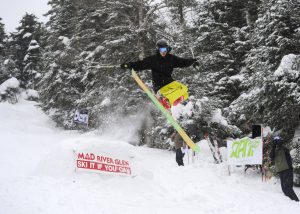 MAD RIVER’S TRIPLE CROWN
MAD RIVER’S TRIPLE CROWN
Even before the Castlerock Challenge, the Mad River Unconventional Terrain Challenge was a proving ground. The brainchild of Wendy Bridgewater, a telemark skier who worked ski patrol at the mountain, it was a ski-it-if-you-can showdown on the rocky, mogul-ridden natural terrain of the Chute trail beneath Mad River’s iconic single chair. “That was really at the beginning of extreme skiing in the East and the top spots were an automatic ticket (with airfare and hotel provided) to the finals out West,” says Mad River’s communications director, Eric Friedman. And Mad River skiers took those spots with force.
In 2011, three MRG vets—brothers Lars and Silas Chickering-Ayers and Tom Runcie—stood on all three steps of the podium at the Subaru U.S. Extreme Skiing Championships at Crested Butte. In the women’s division, Angel Collinson won and Jay Peak skier Ashley Maxfield, finished third.
As if the Unconventional Terrain Challenge (to be held Feb. 17, 2018) were not tough enough, MRG added a Mogul Challenge (Mar. 10) and then the Vertical Challenge (Mar. 2) in 1999 to see how many laps you could compete on the Single Chair in one day (9 am to 4 pm). “That first year Doug Lewis went toe-to-toe with Tiger Baird,” Eric Friedman recalls. “Those guys went at it all f-ing day, arcing these GS turns down through the mogul fields.” Lewis, who lives in Waitsfield, won the bronze in downhill at the Bormio Olympics. Baird works ski patrol at Mad River Glen and runs Tiger’s Auto Repair in town.
The pair ended up setting a record that stood for a long time, skiing 27 runs on the 2,000-vertical-foot course—Lewis edging Baird out by 20 seconds on the last run. “And that was on the old chair, which took about 9 and half minutes to get to the top,” Friedman recalls.
Since the single chair has been upgraded, times have gotten faster. Local MRG skier Aidan Casner, a World Cup downhill mountain bike racer, now holds the record at 31 runs. “He just showed up to ski that day, not even knowing the event was going on, and decided to enter—I don’t think he could walk the next day,” Friedman recalls. “And I don’t think it’s physically possible to do it any faster.” But you can always try. This year: Feb. 27, Mar. 2, Mar. 10, 2018; madriverglen.com
KILLINGTON’S BEAR MOUNTAIN MOGUL MADNESS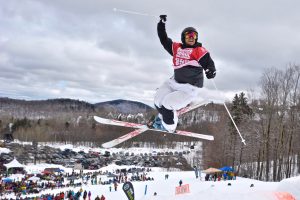
In 2012, Killington attempted the unthinkable: after 31 years of consecutive events, it tried to cancel the Bear Mountain Mogul Challenge. The reason, resort officials said at the time, was liability.
You might think that would refer to the number of ACLs strained as skiers zippered down the Outer Limits course, knees moving like sewing machines through bumps the size of VW vans. You might think it was because of herniated discs or the daffys that people hucked mid-race. But no, the reason had nothing to do with what was going on up on the hill: it was the insanity of the tailgate parties where the competition to down a shot-ski or do a keg stand was just as fast and furious.
Skiers revolted at the decision. Locals banded together and held the Denial Cup. And a year later the Bear Mountain Mogul Challenge was back, complete with costumes, and head-to-head competition on the Outer Limits mogul field, the same that helped train local stars Donna Weinbrecht and Hannah Kearney for Olympic glory.
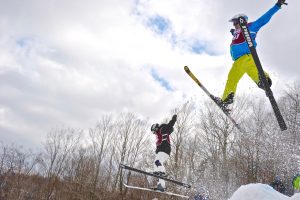 But what makes BMMC (now called the Dos Equis Bear Mountain Mogul Challenge and is part of the Killington’s Nor’Beaster rites of spring) unique is this: it’s only for amateurs. No one who has competed on the USSA circuit in the last five years is allowed to compete. Contestants are scored on Turns & Line (60 percent), Air (20 percent —no inverted aerials, please) and Speed (20 percent). There are prizes for men and women in age groups that start at 13 and under and go to 50 and older. And the list of “party tips” (e.g. no fireworks, no kegs) is now longer than the actual rules of competition—safety first.
But what makes BMMC (now called the Dos Equis Bear Mountain Mogul Challenge and is part of the Killington’s Nor’Beaster rites of spring) unique is this: it’s only for amateurs. No one who has competed on the USSA circuit in the last five years is allowed to compete. Contestants are scored on Turns & Line (60 percent), Air (20 percent —no inverted aerials, please) and Speed (20 percent). There are prizes for men and women in age groups that start at 13 and under and go to 50 and older. And the list of “party tips” (e.g. no fireworks, no kegs) is now longer than the actual rules of competition—safety first.
Don’t worry though, there’s still a Dos Equis Stein Hoisting Championship and live music by Jamie and the Junk Show. The party’s not over. Far from it. This year: April 6-8, 2018; killington.com
24 HOURS, UP AND DOWN, AT BOLTON
There are dozens of races that challenge skiers to do downhill laps over 24 hours, including the 24 hours of Stratton and Aspen’s famed 24-hour race. But Bolton Valley’s 24 hours is a little different: there’s no resting on the uphill, no cushy gondola rides and no sleep—unless you choose to participate as a relay.
Open to skiers or splitboarders, it’s a downhill-uphill ski mountaineering challenge where you skin up, ski down, then wash, rinse, repeat, from noon on Saturday (Feb. 10) until noon on Sunday (Feb. 11). The winner? Whoever has logged the most vertical. In 2017, the first year of the race, Dave Irving of New Hampton, N.H. logged 24,050 feet of vertical to win, topping the field of 50, with Leslie Burnard of Maynard, Mass. scoring 15,485 feet of vert as the top female.
There are, as mentioned, options to do this as a relay. Or to limit yourself to a 12-hour challenge. But what’s the fun in that? Put on by Native Endurance, the race benefits Vermont Adaptive, so it’s all for a good cause. This year: Feb. 10-11, 2018; nativeendurance.com or boltonvalley.com
MAGIC’S ULTIMATE SKIER CHALLENGE
With new ownership in 2016 and a renewed vitality, it’s clear that Magic Mountain is not going to be your typical ski area. One of the first things to appear on the events calendar this season was a series of challenges that’s clearly upping the ante.
First, on December 31, there was Tuck It: The Dash for Cash – a straight-out speed comp where a radar gun clocked skiers and riders as they straight-lined down for $1,000 in prize money. Collegiate ski racers Kazui Kasumi and Austin Lilley both smoked the course, clocking 74 mph on the straight. Kasumi earned top honors by having a faster first run (73 mph, versus Lilley’s 74). To put things in perspective, Cody Wilson, who finished third, won the U18 Nationals speed event in 2014. In other words, these were not your average jeans-wearing, arms-flailing, straight-liners. They knew what they were doing, and they smoked it.
Bummed you missed that fun? Next up, Magic plans to throw a gate or two on course for the Ultimate Skier Challenge on March 17, which will involve a freeski competition on the top half of Black Line that will segue seamlessly (or not, depending on skill) into a GS course. “It’s about finding the best all-around skier,” says president Geoff Hatheway. Our bet is on Kasumi. This year: March 17, 2018; magicmtn.com
FAT FUN AT THE STOWE DERBY
It started in 1945 as a bet between Austrian alpine instructor Sepp Ruschp and his Nordic nemesis, Erling Stromm, a Norwegian mountaineer. The challenge was simple: Using only one pair of skis, see who could make it from the top of the Toll Road trail on Mt. Mansfield down to the center of town in Stowe, faster. Ruschp, using alpine gear, won.
Nowadays, most Derby racers opt for Nordic gear—classic or skate skis and there are two starts, one for each division—and fat bikes. The 20-kilometer course is not so simple. While skiing down Toll Road might seem like a cake-walk on alpine gear, try negotiating the hair-pin turns on skinny skis with three or four other skiers who started with you all on the inside. There is a reason why spectators line up at each turn.
While some of the racers are national-caliber and NCAA Nordic champs, the majority are not. For many, simply finishing without a crowd-pleasing fall is a goal. For others, there’s an added Derby Meister challenge of doing the course once on skate skis (freestyle division) and then taking a bus from the finish in town back up to the mountain to compete in the classic ski division that starts later. And new in 2015, there was a chance to partake in the madness on a fat bike (separate start, after all the skiers are off the course) and be a Fat Meister as well.
The race is dependent on snow covering the valley floor, and the last two years it’s been shut out due to weather. But that’s all the more reason to sign up this year.
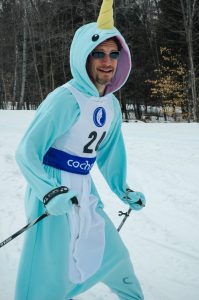 COCHRAN’S NORDIC X
COCHRAN’S NORDIC X
Leave it to the Cochran family, three generations of alpine ski racers with a passel of Olympic and World Cup medals between them, to come up with a Nordic race like this. Billed as the first “Nordic Ski Cross Event in New England” Nordic X launched in 2014. There was uphill. There was downhill. There were slalom gates – and some trees. There were jumps. And all of this to be negotiated by four skiers, who launched from the starting gate at once, boardercross style.
Costumes were plentiful and after, there was a pancake breakfast for competitors.
And thus, a tradition was born. Now, each spring, Nordic X challenges top alpine racers, including the likes of Bobby Cochran, Jimmy Cochran and Mike Ryan (Bode Miller’s former coach). In 2017, Nordic national champion Caitlin Peterson competed as well as U.S. Cross-Country Ski Teamer Ben Ogden.
“We always have it at the end of the season so no one is worried about getting hurt before a race,” says organizer Pennie Rand. And for anyone who has a hankering for a good pancake breakfast, the Slopeside maple syrup the Cochrans pull from the maples on the hill is as sweet and local as it gets. This year: April 8, 2018; cochranskiarea.com

